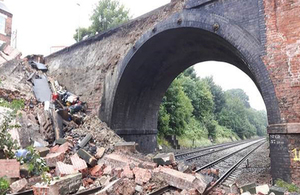Report 10/2017: Partial collapse of a bridge at Barrow upon Soar
RAIB has today released its report into the partial collapse of a bridge onto open railway lines at Barrow upon Soar on 1 August 2016.

Image showing partial bridge collapse at Barrow upon Soar
Summary
At around 23:50 hrs on 1 August 2016, a bridge carrying Grove Lane in Barrow upon Soar, Leicestershire, over the Midland Main Line, partially collapsed and a large volume of masonry fell onto the railway lines below. At the time of the collapse, core sampling work was being undertaken to investigate localised subsidence in the footpath on the south side of the bridge. The bridge was closed to the public when the collapse occurred, but the railway lines below were open to traffic.
When the coring had reached about 1.4 metres below ground, water appeared at the surface and shortly afterwards, the adjacent wall fell away from the side of the bridge, taking with it part of the footpath, a length of cast iron water main and the core sampling rig. Five workers were able to get clear as the collapse occurred and no-one was injured. Two of the four railway lines through the bridge were completely obstructed and there was debris on a third. There were no trains on the immediate approach to the bridge at the time of the collapse.
The RAIB investigation found that the incident occurred because the bridge wall, built around 1840, was not designed to resist overturning. It had also been weakened by a full- height vertical crack. The water main, which ran close to the vertical crack, probably had a slow leak which was causing on-going subsidence in the footpath. Prior to 1 August, however, there was no evidence that the wall was at risk of imminent collapse.
The coring work on the night of the incident disturbed the pressurised water main and it ruptured. The consequent release of water behind the wall quickly overloaded it and caused the wall to overturn about its base.
Underlying the incident was the lack of understanding of the risk posed to the structure and to the open railway from coring in proximity to the water main.
Recommendations
The RAIB has made two recommendations to Network Rail. The first relates to the competence of its staff and contractors, and the availability of information to enable them to manage the potential risk to its structures from breaches of water utilities. The second relates to the provision of appropriate engineering input to risk assessments for intrusive investigations and masonry repairs on bridges carrying water services. A further recommendation is made to Network Rail’s contractor, Construction Marine Limited, about the improvement of processes relating to street works and the location of water services.
The report has identified a learning point to reinforce the requirement for bridge examiners to report evidence of underground services and any changes since the previous inspection to enable a possible connection to be drawn between a water main and observations of defects on the bridge.
Notes to editors
- The sole purpose of RAIB investigations is to prevent future accidents and incidents and improve railway safety. RAIB does not establish blame, liability or carry out prosecutions.
- RAIB operates, as far as possible, in an open and transparent manner. While our investigations are completely independent of the railway industry, we do maintain close liaison with railway companies and if we discover matters that may affect the safety of the railway, we make sure that information about them is circulated to the right people as soon as possible, and certainly long before publication of our final report.
- For media enquiries, please call 01932 440015.